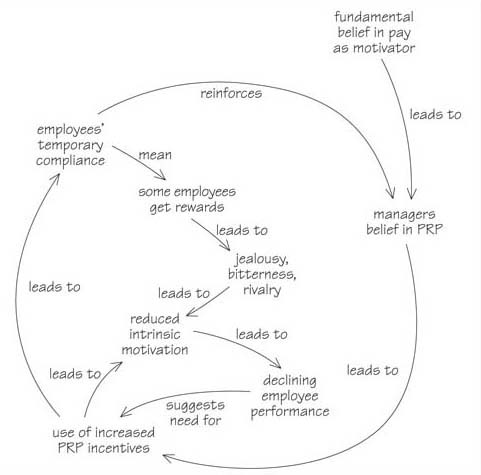3.4 Thinking through diagrams
One of the features that characterises complex situations is the interconnectedness of the components within them. Understanding such situations can defeat our descriptive abilities. Words alone either confuse still further or misrepresent the situation altogether. For this reason, diagrams are a characteristic feature of systems approaches to understanding complex situations. Diagrams allow the relationships between parts of the situation to be seen at the same time as the parts themselves. Figure 3 is an example. Imagine trying to write Figure 3 down in words. You might conceivably start your first sentence with any one of the components. You would then use the words of the arrow labels to connect each component with the one that follows. Finally, you would have to say that in fact the last link of the chain is connected to the first. It would take several sentences and would be tricky to ensure that the reader understood that the links were at least as important as the components. The reader might also get the impression (even though you didn't mean it) that the first component you mentioned was somehow the one that ‘starts it off’.

Whether you agree with the arguments expressed in Figure 3 or not, I hope that you can now appreciate that diagramming is a way of representing complex situations that allows us to represent the complexity while seeing the individual components and their connections to other components at the same time. One of the problems with written accounts is that they are ‘linear’. In other words, the sentences follow one after another, in a given order. This is fine for accounts of events that do happen in sequence, but not where things are intimately connected and do not come in a particular order, or form various circles of activity that reinforce particular behaviour. The type of diagram shown in Figure 3 can be seen as a series of interconnected sentences. But the sentences have escaped from the normal linguistic convention in which one sentence follows another in order. In making that escape, a whole new way of thinking opens up. But like ordinary language, there is more to understanding diagrams than the words they contain. To convey their full meaning, they must follow conventions, much as a list of words must follow grammatical conventions to become a meaningful sentence. Understanding and being familiar with the conventions allows you to convey a wealth of meaning in your diagrams.
Another reason for using diagrams is the way that they highlight things that are effectively disguised by using text; for example the interconnectedness between apparently unrelated events or activities. They do this by providing another viewpoint. So diagrams are not simply for the diagrammer to convey meaning to a reader. Diagrams make the diagrammer aware of previously unrealised features of the situation. I have been using diagrams for a long time now and I'm still astonished by the powerful insights they give me. One useful technique is to draw diagrams while reading. You can supplement the author's choice of diagrams with ones that suit you personally, or you can convert text to diagrams that suit you. Another useful technique is to carefully scrutinise the diagrams people use to see what they reveal and what they conceal about a situation.
